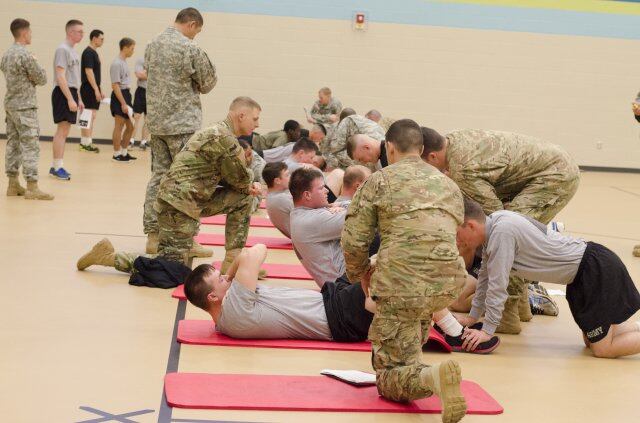A pilot program designed to solve the U.S. Military Academy's top problem with prior-service candidates could help those candidates, even the unsuccessful ones, succeed outside of West Point.
Fort Campbell, Kentucky, hosted the first Rapid Application Completion Exercise last month, with about 75 soldiers on hand to tackle a deceptively simple mission.
"The No. 1 thing you always hear is that it's hard to get soldiers to finish their application," said Maj. Jason Dupuis, West Point's soldier admissions officer. "Because soldiers don't have Mom and Dad there helping them. And an application to West Point is not more important than them doing their job as a soldier."
So in addition to flagging unit leaders on soldiers that might make good fits for USMA, Dupuis put together RACE, which he compared to pre-deployment soldier readiness processing.
Soldiers start with the six-event Candidate Fitness Assessment, fill out their online paperwork, take the medical exam, even register to take or re-take required standardized tests. They also benefit from having West Point admissions experts on site to offer advice on improving their chances or to track down missing pieces of their file — high school transcripts, for example.
Ideally, Dupuis said, soldiers would enter RACE day with ACT or SAT scores already on file with West Point, a nomination from their company commander (necessary for admission) and some prep time for the CFA (see box). Failing that, he said, "just show up on the morning of the RACE hydrated and ready to go. Even if nothing is done ahead of time, a full day focused on completing this application is way better than doing it piecemeal."
Side benefits
West Point has up to 170 prior-service soldier slots available for each year's class — half of those are active-duty, and not all are filled each year. There is no strict quota, as troops must compete with other applicants for admission. Those who don't make the cut may be eligible for the USMA Preparatory School, which provides 10 months of focused academic work and counts as a year of service toward retirement, GI Bill eligibility and other benefits.
Even soldiers who fall short could realize long-term benefits from opening an application file and participating in the RACE program, Dupuis said. Following advisers' recommendations regarding college-prep classes, re-taking standardized tests and other application-boosters will improve a soldiers' chances at achieving any education goals, not just reaching West Point. Also, the physical exam required for USMA entry is the same for those who may consider the Green-to-Gold Program as a path to a commission.
Plans call for RACE events at bases in Alaska later this month, and Dupuis, himself a prior-service West Point grad, hopes to take the road show to Fort Benning to work with Ranger battalions — a strong source of prior-enlisted applicants.
If the early tests go well, he said, "by end of this summer, from July to October, every major installation in the Army is doing a RACE."

The Rapid Application Completion Exercise is designed to help prior service candidates.
Photo Credit: Army
Installation guidance
Some of the RACE day activities required organizers to get creative, said Maj. Eddie Porter, who served as the 101st Airborne Divison's liaison officer for the event.
The academy fitness test is designed primarily for a single applicant to take with a single proctor, for instance, but Porter and company figured out a way to break the soldier pool into groups and get them through the gym under the test's guidelines.
The group also exceeded the base's computer-lab capacity, Porter said, so a distributed learning center was used as a base of electronic operations.
His advice for upcoming RACE hosts: "You've got to plan, plan, plan. And you've got to advertise it: Get it in the local newspaper, Facebook, social media pages, posters in the cafeteria. The more you spread the word, the more people are interested."
USMA notes
CFA 101: The Candidate Fitness Assessment includes a basketball throw, cadence pullups, shuttle run, situps, pushups and a one-mile run, with prescribed rest periods between events. Women can choose a flexed-arm hang in lieu of pullups, but those who manage one correct pullup will score higher than any hang time.
Age limits: Candidates cannot turn 23 years old before July 1 of the year their class enters West Point. That means prep-school soldiers can't turn 22 before heading to USMAPS. Congress had approved age waivers for soldiers deployed in support of anti-terrorism operations, but those expire in 2016, before the next application cycle.
First steps: Whether you're prepping for a RACE or want to apply on your own, visit www.usma.edu/applynow for the basics. Email jason.dupuis@usma.edu with questions and to allow West Point to better monitor your application process.
Kevin Lilley is the features editor of Military Times.





